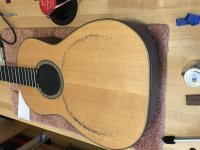Just finished gluing up first side. I used 56g of epoxy for one side glue up. The panels are 9 x 24 inches. The pattern impressed onto the spread out glue confirms transfer of glue to nomex core. Epoxy is thixotropic so I am hoping ie will form a fillet as illustrated between mylar and nomex. I will let the glue dry 24 hours. Glue vacuum bagging might speed this process. After this side is dry I will repeat on the other side. It is important to spread glue with same credit card that you bought your Nomex, Mylar or CF. Destroy card after use for safety
One concern is that the Mylar might stretch. I really didn’t stretch it I just pulled and smoothed it out flat. It this is a problem the panel can be gently heat shrunk with a heat gun(old ESL trick).
Keep suggestions coming.
One concern is that the Mylar might stretch. I really didn’t stretch it I just pulled and smoothed it out flat. It this is a problem the panel can be gently heat shrunk with a heat gun(old ESL trick).
Keep suggestions coming.
Attachments
-
 63B1E901-2254-4881-A82C-C234AACD20B2.jpeg312.3 KB · Views: 409
63B1E901-2254-4881-A82C-C234AACD20B2.jpeg312.3 KB · Views: 409 -
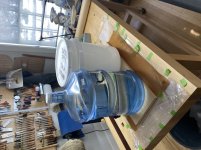 01F672C8-759F-44E3-B4F3-1CBB7CDB7166.jpeg365.4 KB · Views: 224
01F672C8-759F-44E3-B4F3-1CBB7CDB7166.jpeg365.4 KB · Views: 224 -
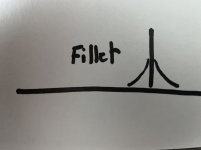 0703DA1F-BA03-40B9-AEDB-45FCF454C5E6.jpeg152 KB · Views: 218
0703DA1F-BA03-40B9-AEDB-45FCF454C5E6.jpeg152 KB · Views: 218 -
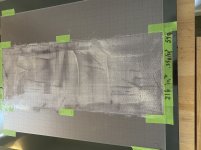 70551332-BE9F-4F2A-B1AD-DD1D0BF2F11A.jpeg328.6 KB · Views: 231
70551332-BE9F-4F2A-B1AD-DD1D0BF2F11A.jpeg328.6 KB · Views: 231 -
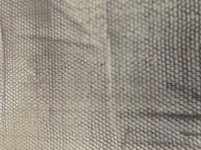 A77E8CA6-F596-46E1-8E9C-F6DC0524AD19.jpeg336.4 KB · Views: 231
A77E8CA6-F596-46E1-8E9C-F6DC0524AD19.jpeg336.4 KB · Views: 231 -
 425E08BC-208E-4371-80A5-2D404659B085.jpeg287.6 KB · Views: 214
425E08BC-208E-4371-80A5-2D404659B085.jpeg287.6 KB · Views: 214 -
 5BADE14B-B0E3-4BC8-8195-F83D4A013310.jpeg248.1 KB · Views: 389
5BADE14B-B0E3-4BC8-8195-F83D4A013310.jpeg248.1 KB · Views: 389 -
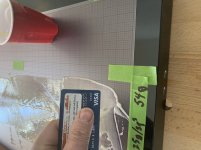 166C6081-111B-44B8-BAFA-99F44567CA37.jpeg254.6 KB · Views: 381
166C6081-111B-44B8-BAFA-99F44567CA37.jpeg254.6 KB · Views: 381 -
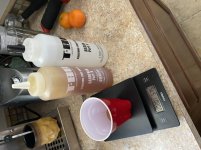 4D303A34-7913-4C4B-BE29-87E42136D5CA.jpeg305.3 KB · Views: 388
4D303A34-7913-4C4B-BE29-87E42136D5CA.jpeg305.3 KB · Views: 388 -
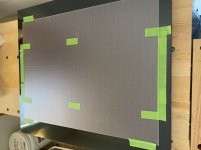 A3DD0603-3F94-4435-A36C-02739FA34B85.jpeg257.2 KB · Views: 417
A3DD0603-3F94-4435-A36C-02739FA34B85.jpeg257.2 KB · Views: 417
Sorry about picture orientation. Posting seems to prefer landscape and rotates portrait to landscape.
Looking forward to the results of testing. Don't think badly of them if they don't do well in the low range. Play something restricted to mids and up then see how well they do in terms of intelligibility. If they do well in that range they're successful.
I have read that below 100-200 hz a really big panel is needed. In my implementation I cross over to twin open baffle Altec 15’s via biamping anyway. If this experimental panel works well I plan to make one 24x48 inches or larger. I still expect to use big OB subs.
Might build an experimental panel with .1mm CF woven film next. Not sure if this is available pre-preg or how to work with this thin CF. Cooking thin big panels is problematic
Might build an experimental panel with .1mm CF woven film next. Not sure if this is available pre-preg or how to work with this thin CF. Cooking thin big panels is problematic
Just finished gluing up first side.
Dave,
From your pics it looks like you build guitars, yes? Ever built any doubletops? Seems like a lot of the same principles should apply.
Regarding the mylar properties, I think it's the elastic modulus that matters more than the tensile strength. But maybe that's what you meant.
Eric
Yes I build guitars. And yes I build double tops. That is why this topic (DML’s) are of such interest to me. I regularly do modal analysis of guitar tops during construction and I have all the “stuff” for modal analysis and modification as well as some composites and lamination experience. Music, Hi End Audio and everything guitars including building are my hobby loves.
Meanwhile.. Back at the Dollar Tree..
I grabbed a couple of these dry erase boards and stuck a couple of the Parts Express exciters to them.. Not bad..
https://www.dollartree.com/jot-dry-erase-boards-with-eraser-topped-markers/178414
Gonna thin out some Mod Podge with water and soak the cardboard down real good and let it dry. It'll brighten the sound up, like I used to do with paper cone speakers in the 80's using spray starch and a hair drier.. 😉
I grabbed a couple of these dry erase boards and stuck a couple of the Parts Express exciters to them.. Not bad..
https://www.dollartree.com/jot-dry-erase-boards-with-eraser-topped-markers/178414
Gonna thin out some Mod Podge with water and soak the cardboard down real good and let it dry. It'll brighten the sound up, like I used to do with paper cone speakers in the 80's using spray starch and a hair drier.. 😉
I had a little .25 mil Mylar from my ESL days and some Nomex honeycomb 1.8 lb
Feedback is welcome, please!
Hmm. I must admit I had not thought about using an un-reinforced plastic as the skin for a skin/core/skin DML, but it's worth trying. Mylar (PET) has a modulus comparable to wood (good), while a quite a bit denser than wood (bad), and available much thinner than wood (also good).
But at 0.25 mil, it will probably buckle on the compression side of the panel, and not really provide the stiffness that it otherwise would.
My gut feeling is that you will probably need a Mylar that is more like 5 mils thick to avoid buckling. But I'm eager to hear what you find.
Eric
Yeah I thought of what you said. Might buckle. I am trying to push the beam theory idea to an extreme. We shall see. [emoji28]. I’ll keep posting either way
One time I built a guitar top at .030 thickness. It’s biggest problem, other than fragility, was that it luffed like a sail between the braces when excited. I am afraid that might happen between the cells of the nomex. We shall see. Further, the panel might need some heat treatment to tighten it up.
One time I built a guitar top at .030 thickness. It’s biggest problem, other than fragility, was that it luffed like a sail between the braces when excited. I am afraid that might happen between the cells of the nomex. We shall see. Further, the panel might need some heat treatment to tighten it up.
I regularly do modal analysis of guitar tops during construction and I have all the “stuff” for modal analysis and modification as well as some composites and lamination experience.
Wow. Nice. We need you here. Tell us about the stuff you have for modal analysis! Do you mean something for predicting, like finite element, or do you mean something for measuring? I don't know what the "stuff" is but I want to!
Eric
Stuff:
A signal generator with integral amp
A vibrator for stimulating panels
I measure MOE using static and dynamic methods as well as noninvasive ultrasonic methods
Workstation for stimulating Chladni patterns in plates or complete instruments.
Lots of paprika, sand and poppy seeds
This is old school but it works ( No shop scanning laser Interferometer but I do have access to one at the local engineering school)
A signal generator with integral amp
A vibrator for stimulating panels
I measure MOE using static and dynamic methods as well as noninvasive ultrasonic methods
Workstation for stimulating Chladni patterns in plates or complete instruments.
Lots of paprika, sand and poppy seeds
This is old school but it works ( No shop scanning laser Interferometer but I do have access to one at the local engineering school)
Further, the panel might need some heat treatment to tighten it up.
That's a great idea. If both skins are in enough pre-tension, they won't buckle in compression. Seems tricky to get right.
How thick is your Nomex? I'm doing calcs based on 1/8" and I'm getting pretty good numbers for a Mylar thickness of about 2 mils. Different Nomex thickness likely will be different.
I also suspect the results will be pretty sensitive to glue weight, as you already seem to be aware.
Eric
My NOMEX is 3mm. The Mylar is 1/4 mil. The ultimate weight of this panel won’t be more than a few oz. I use the same technique to make double tops in that I put a measured (g/in^2) amount of epoxy on a third surface precisely quantified then set the Nomex in the spread out epoxy. This transfers a minimal amount of epoxy to the Nomex and should keep the contribution of the epoxy to the weight of the panel next to nothing. Using less epoxy on the spreading table won’t transfer enough epoxy to the Nomex and could result in delamination. I put in a little extra above the known minimum amount.
I am hoping this works as it would reduce the cost of a honeycomb panel by 7-800 dollars by not using CF
Eric,
Getting good numbers? Do you have FEA capability?
I do. But I mean "good numbers in terms of B/mu^3, for which I don't need FEA.
Eric
Wow, when I play your speakers thru mine your speakers sound like mine. Maybe we are onto something. [emoji57][emoji1787]
Seriously, sounds like a great experiment.
Yeah! I always laugh when I see an ad on TV for a new television showing me how much clearer the blacks are and how much sharper the picture is! Always makes my old TV look better too. 😀
- Home
- Loudspeakers
- Full Range
- A Study of DMLs as a Full Range Speaker
